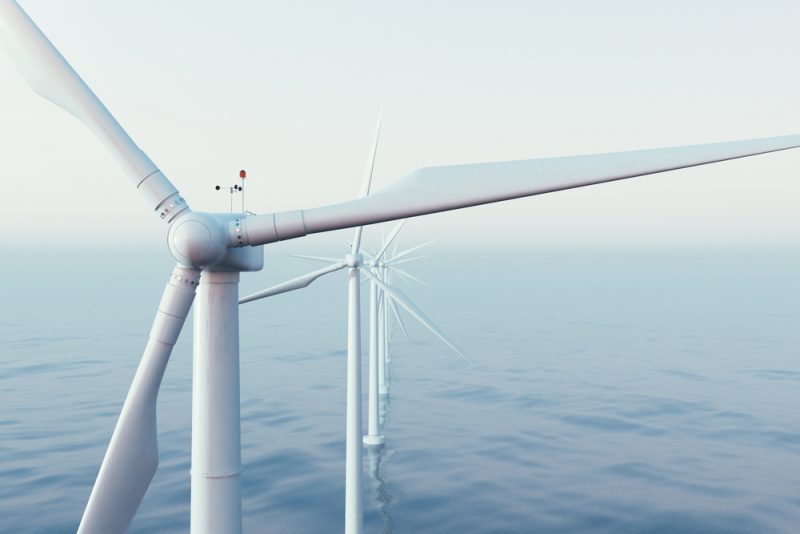Floating turbines expand offshore wind possibilities

A new gust of development is coming for the offshore wind energy industry in the United States, with high-performing turbines mounted on floating platforms likely to have a major role in the upcoming growth spurt.
The U.S. Department of the Interior announced in October that it was taking the administrative steps to increase electricity production from offshore wind turbines along the Massachusetts, Rhode Island and California coasts. The move coincidentally was made at the same time state governments and the private sector have been looking to wind as a major ingredient in their future energy mix rather than as a dream still not practical enough for the real world.
“We are always looking at new ways to increase American innovation and productivity to provide abundant and affordable energy for our homes and manufacturers,” said Interior Secretary Ryan Zinke. “I think this is a win for America.”
Zinke added that he was “very bullish on offshore wind, and that harnessing this renewable resource is a big part of the Trump Administration’s ‘made in America’ energy strategy.” But the Secretary is hardly going out on a limb. In September, the American Wind Energy Association (AWEA) said the estimated potential capacity of wind-generated power in U.S. waters was “more than 2,000 gigawatts (GW), or nearly double the nation’s current electricity use.”
The AWEA said further that the Department of Energy pegged the pipeline for offshore wind projects as of June 2018 at 25,434 megawatts (MW), most of which were earmarked for currently undeveloped lease tracts.
“While a majority of the nearer-term activity is concentrated in the Atlantic off the Northeast coast, projects have also been proposed off the Southeast coast, in the Pacific off California and Hawaii, and in the Great Lakes,” the AWEA said. “With stable policies in place, the Department of Energy found that the U.S. could develop a total of 22 GW of offshore wind projects by 2030 and 86 GW by 2050.”
That’s a lot of electricity, and it will require a sizable fleet of turbines parked off the various coasts to capture those generous sea breezes. And the AWEA noted in October that offshore turbines typically are rated at 6 MW or higher – while on land only two wind farms currently in operation use turbines rated above 3.5 MW. The average utility-scale wind turbine installed last year was rated at 2.32 MW, which the AWEA said was enough to power over 750 American homes for a full year. Utilities signed contracts for 1,522 MW of wind capacity in the third quarter, including the largest procurement of U.S. offshore wind to-date from the 800 MW Vineyard Wind project off Massachusetts.
Floating platforms enable generators to move farther offshore where the winds blow stiff and steady, and where the spinning turbines are largely out of sight and out of the minds of coastal residents who might object to permanent towers breaking up their ocean views. Floating platforms also make it possible to set up shop in deeper waters or in areas where the seabed isn’t conducive to planting a permanent tower on the bottom.
One such deep-water tract lies off Viana do Castelo on the northern coast of Portugal where the proposed Windplus wind farm located 12.4 miles off the coast received a loan of €60 million euros ($68,059,500) from the European Investment Bank (EIB) on Oct. 19. The Windplus project will be located where the ocean depth at the site is between 279 and 328 feet, which is considered economically impractical for a permanent fixed-bottom tower. The developers plan to deploy three floating turbines rated at a hefty 8.4 MW of capacity, giving the project a total capacity of slightly more than 25 MW, or enough to supply about 60,000 European homes annually.
For the EIB, the investment makes sense since some 80 percent of Europe’s prime offshore capacity is in areas with ocean depths of 197 feet or greater. And for Windplus, it is an evolutionary step.
“This financing represents a major milestone for Principle Power and for the floating wind industry, as it fully demonstrates the financeability of the technology, and its readiness for commercial deployment globally,” Principle Power CEO Joao Metelo said in a written statement. Principle Power, a development, technology and services provider to the offshore wind industry, has developed a floating wind turbine foundation.
Floating platforms are included in at least one proposal for offshore wind in the United States. The Redwood Coast Energy Authority (RCEA) and its partners this fall submitted a lease application to the Interior Department’s Bureau of Ocean Energy Management for a 100-150 MW floating wind farm 20 miles off Eureka, Calif. The plan calls for between 10 and 15 turbines that will be out of the way of the merchant ships and commercial fishing vessels that use Humboldt Bay, while at the same time contributing to California’s campaign to use 100 percent clean power by 2045.
“Humboldt County has much to gain by harnessing our offshore wind power potential,” said Humboldt County Supervisor and RCEA board member Estelle Fennell. “We are at the very beginning of a multi-year process, but so far, the response from the public has been positive,” she said in September.
The areas affected by the Interior Department’s actions this fall will also include fixed-mount turbines in shallower waters, but the most important outcome down the road is shaping up to further advancement of floating-turbine technology and acceptance of offshore wind farms by the public.
